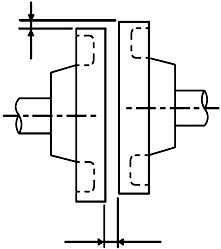Installation
and dimension
Servo
motor
Servomotor
can be installed either horizontally or vertically. However, if the
servomotor is installed with incorrect mechanical fittings, the servo
motor’s lifetime will be greatly shortened and unexpected
accidents will occur.
Please
make installation according to the instructions as below:
Precaution:
There’s
some antirust agent on the edge of the motor shaft to prevent it from
rusting during storage. Please wipe off the agent thoroughly by using
a cloth dipped with diluting agent or thinner before installing the
motor.
NOTE:
The diluting agent should not touch any other parts of the servomotor
when wiping the shaft.
1)
Storage
temperature When
the servomotor is not in use, it should be kept in a place with an
environment temperature between −20°C and
+60°C.
2)
Installation
site Servomotor
should be installed indoors, and the environment should meet
following conditions:
-
Free
from corrosive, inflammable or explosive gases
-
Well
ventilated and free from dust and moisture
-
Ambient
temperature is between 0°C and 40°C
-
Relative
humidity is between 26% and 80% RH (non-condensing)
-
Maintenance
and cleaning can be performed easily
3)
Installation
concentricity
Use
elastic shaft connectors as many as possible for mechanical
connections. The axis centers of servo motor and mechanical load
should be kept in thesame line. If a shaft connector is used when
installing servo motor, it has to meet the requirement of
concentricity tolerance as shown in the illustration below. Measure
this at four quartering positions of a cycle. The difference between
the maximum and minimum measured value must be less than 0.03mm.
(Rotate together with shaft connectors)

Note:
If
the concentricity tolerance is too big, mechanical vibration will
occur, resulting in damage to the bearings of servo motor
Never
strike at the axis direction when installing shaft connectors, this
could damage easily the encoder of servo motor.
4)
Installation direction The servomotors
can be installed,
horizontally, vertically or in any direction.
5)
Handling oil and water If the servomotor
is installed at a
location subject to water, oil, or condensation, the motors require
special treatment to meet protection requirements. If the motors are
required to meet the protection requirement before leaving the
factory, it’s necessary to designate the exact motor models
with oil seal. Shaft through section means the gap as shown in the
following picture:

6)
Cable
tension When
connecting the cables, the bending radius shouldn’t be too
small, do not apply big pulling force to cables.
Please
be noted in particular that the diameter of signal cable wires is
very small, from 0.2 mm to 0.3 mm, therefore handle the cables with
adequate care and do not cause excessive cable tension while doing
wiring.




